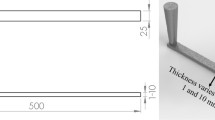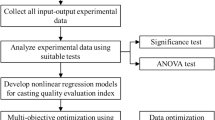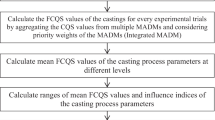Abstract
Modeling of pressure die casting process is carried out in the present work. Design of experiment has been utilized to collect the experimental data. The input–output relations have been developed by using response surface methodology. Optimal process parameters have been determined by using desirability function. The process parameters, namely, fast shot velocity, injection pressure, phase changeover point, and holding time, have been considered as the input to the model. Porosity, surface roughness, and hardness are measured and represented as the responses. Based on the experiments carried out, two nonlinear models have been developed using central composite design and Box-Behnken design. These two models have been tested for their statistical adequacy and prediction accuracy through analysis of variance (ANOVA) and some practical test cases, respectively. The performance of central composite design is found to be better than Box-Behnken design (BBD) for the response surface roughness and hardness, whereas the latter is found better than the former for the response porosity. The performance is adjudged based on the average absolute percent deviation in predicting the responses. The absolute percent deviation values for the responses surface roughness, hardness, and porosity are found to be equal to 5.95, 1.29, and 63.94, respectively, in central composite design (CCD). On the other hand, corresponding values in BBD are found to be equal to 14.19, 3.04, and 4.94. Further, an attempt is made to minimize the porosity and surface roughness along with maximization of hardness of die cast component. The objective of multi-response optimization was met with a high desirability value of 0.9490.
Similar content being viewed by others
References
Rai JK, Lajimi AM, Xirouchakis P (2008) An intelligent system for predicting HPDC process variables in interactive environment. J Mater Process Technol 203:72–79
Lee SG, Gokhale AM, Patel GR, Evans M (2006) Effect of process parameters on porosity distributions in high-pressure die-cast AM50 Mg-alloy. Mater Sci Eng A 427:99–111
Tsoukalas VD (2008) Optimization of porosity formation in AlSi9Cu3 pressure die castings using genetic algorithm analysis. Mater Des 29:2027–2033
Syrcos GP (2003) Die casting process optimization using Taguchi methods. J Mater Process Technol 135:68–74
Gunasegaram DR, Farnsworth DJ, Nguyen TT (2009) Identification of critical factors affecting shrinkage porosity in permanent mold casting using numerical simulations based on design of experiments. J Mater Process Technol 209:1209–1219
Chen C, Chuang M, Hsiao Y, Yang Y, Tsai C (2009) Simulation and experimental study in determining injection molding process parameters for thin-shell plastic parts via design of experiments analysis. Expert Syst Appl 36:10752–10759
Wu D, Chang MS (2004) Use of Taguchi method to develop a robust design for the magnesium alloy die casting process. Mater Sci Eng A 379:366–371
Verran GO, Mendes RPK, Valentina LVOD (2008) DOE applied to optimization of aluminum alloy die castings. J Mater Process Technol 200:120–125
Verran GO, Mendes RPK, Rossi MA (2006) Influence of injection parameters on defects formation in die casting Al12Si3Cu alloy: experimental results and numeric simulation. J Mater Process Technol 179:190–195
Chiang K, Liu N, Tsai T (2009) Modeling and analysis of the effects of processing parameters on the performance characteristics in the high pressure die casting process of Al–SI alloy. Int J Adv Manuf Technol 41:1076–1084
Chen C, Su P, Lin Y (2009) Analysis and modeling of effective parameters for dimension shrinkage variation of injection molded part with thin shell feature using response surface methodology. Int J Adv Manufa Technol 45:1087–1095
Sagbas A (2011) Analysis and optimization of surface roughness in the ball burnishing process using response surface methodology and desirability function. Adv Eng Softw 42:992–998
Islam MA, Alam MR, Hannan MO (2012) Multi response optimization based on statistical response surface methodology and desirability function for the production of particleboard. Compos Part B 43:861–86
Attia UM, Alcock JR (2011) Evaluating and controlling process variability in micro-injection moulding. Int J Adv Manuf Technol 52:183–194
Zhang J, Wang Q, Zhao P, Wu C (2009) Optimization of high pressure die-casting process parameters using artificial neural network. Int J Adv Manuf Technol 44:667–674
Krimpenis A, Benardos PG, Vosniakos GC, Koukouvitaki A (2006) Simulation based selection of optimum pressure die casting process parameters using neural nets and genetic algorithms. Int J Adv Manuf Technol 27:501–517
Myers RH, Montgomery DH (1995) Response surface methodology. Wiley, New York
Wu CFJ, Hamada M (2000) Experiments planning, analysis and parameter optimization. John Wiley, New York
Montgomery DC (2001) Design and analysis of experiments. John Wiley, New York
Natarajan U, Periyanan PR, Yang SH (2011) Multiple-response optimization for micro-end milling process using response surface methodology. Int J Adv Manuf Technol 56:177–185
Kamguem R, Djebara A, Songmene V (2013) Investigation on surface finish and metallic particle emission during machining of aluminum alloys using response surface methodology and desirability functions. Int J Adv Manuf Technol 69:1283–1298
Garg SK, Manna A, Jain A (2014) An investigation on machinability of Al/10 % ZrO2(P)-metal matrix composite by WEDM and parametric optimization using desirability function approach. Arab J Sci Eng 39:3251–3270
Jie-min ZHOU, Ji-min WANG, Hong-jie YAN, Shi-xuan LI, Guang-chen GUI (2012) Multiple-response optimization for melting process of aluminum melting furnace based on response surface methodology with desirability function. J Cent South Univ 19:2875–2885
Pontes FJ, Ferreira JR, Silva MB, Paiva AP, Balestrassi PP (2010) Artificial neural networks for machining processes surface roughness modeling. Int J Adv Manuf Technol 49:879–902
El-Sonbaty IA, Khashaba UA, Selmy AI, Ali AI (2008) Prediction of surface roughness profiles for milled surfaces using an artificial neural network and fractal geometry approach. J Mater Process Technol 200:271–278
Dargusch MS, Dour G, Schauer N, Dinnis CM, Savage G (2006) The influence of pressure during solidification of high pressure die cast aluminium telecommunications components. J Mater Process Technol 180:37–43
Minitab 14, Minitab Inc. State College PA, USA
Parappagoudar MB, Pratihar DK, Datta GL (2007) Linear and nonlinear statistical modeling of green sand mould system. Int J Cast Metal Res 20:1–13
Parappagoudar MB, Pratihar DK, Datta GL (2008) Linear and nonlinear modeling of cement-bonded moulding sand system using conventional statistical regression analysis. J Mater Eng Perform 17:472–481
Author information
Authors and Affiliations
Corresponding author
Appendices
Appendix 1
Appendix 2
Rights and permissions
About this article
Cite this article
Kittur, J.K., Choudhari, M.N. & Parappagoudar, M.B. Modeling and multi-response optimization of pressure die casting process using response surface methodology. Int J Adv Manuf Technol 77, 211–224 (2015). https://doi.org/10.1007/s00170-014-6451-x
Received:
Accepted:
Published:
Issue Date:
DOI: https://doi.org/10.1007/s00170-014-6451-x




